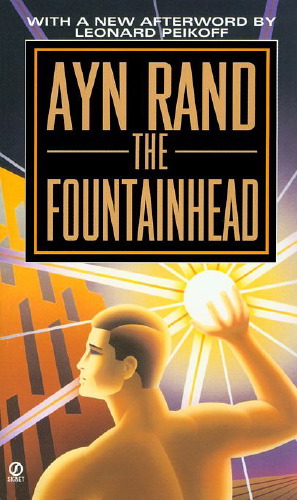In the novel The Fountainhead, author Ayn Rand brings up an innovative and brilliant point about selfishness versus selflessness. Her view on the two is contrary to the majority view; the modern majority associate negative connotations with the term ‘selfish’ and positive with ‘selfless’. Her thinking was ahead of its time when she wrote the book in the 1940s, and still is today, over fifty years later. The conventional connotation with selfishness is that one does what is in their best interest only at the expense of others, and that selflessness is that one does what is best for the greater good, but sacrifices himself in order to do so. Rand saw both of these conventional ideas as flawed; there are too many variables within every situation - every individual person has their own specific needs, adopting such a general idea to prescribe to an entire population full of unique individuals is unrealistic.
Rand believed in the individual, a true original- not someone who was a second-hand copycat just climbing the social ladder in pursuance of approval from others. She believes these people to be selfless: they lack a true sense of self. They spend their entire lives living up to an unrealistic general set of standards in order to be socially accepted, to ride along the paved, comfortable path through life. They are completely engulfed by society’s expectations and thus become one hundred percent dependent on those expectations. By the time their life has reached its end, they are nothing but the cold, hard, shiny plastic exterior that society created for them from their generic cookie-cutter mold. They sold their self and traded it for a dishonest identity, an avatar dragging its feet through a desireless life to the beat of everyone else’s drum; they sold their self so that they wouldn’t have to be unliked, or better yet, alone.
Each person has their own path to follow, and those who choose to follow their path and pursue their desires virtuously, have a true sense of self. Those who possess a sense of self, Rand argues, are able to pursue their talents, values and their self-interests to benefit the greater good instead of sabotaging it. These people have passions, talents, and intense integrity and will not let anything or anyone get in the way of that, even if it means being deemed a social outcast. Other people’s opinions of them, positive or negative, don’t affect them; they seek out their personal values and contribute to society honestly by doing so. Rand refers to these individuals as selfish, and they are the innovative artists, inventors, scientists, educators and great thinkers that have given our world the capability of being progressive.
A few characters from the novel come to mind when the two aforementioned terms are brought up: Howard Roark and Peter Keating. Keating, the epitome of Rand’s definition of ‘selfless’, is a man who cashed in his dreams of being a painter to first pursue a more lucrative and prestigious career in architecture to please his mother, and then later in life cashed in the love of his life for a loveless marriage to please his boss and again, his mother. He graduated at the top of his class at the prestigious Stanton Institute of Technology for architecture, and was hired the day of graduation by a renowned firm, Francon & Heyer in New York City, by partner Guy Francon himself. Working with this firm for decades, Keating eventually climbs to the top of the social ladder, but by the time he gets to the top, realizes how lonely it is up there. At the end of the novel, when there is no more ladder left for him to climb and there is no more love in his life, he realizes the mistakes he has made in being so desperate for approval.
Howard Roark, the epitome of Rand’s definition of ‘selfish’, spent his entire life pursuing what he loved: architecture. He, too, went to Stanton Institute and boarded with Keating and Keating’s mother. Roark never followed by the school’s rules of design and was very ahead of his time in the design world. Modern architecture was frowned upon and laughed at, and because of his refusal to conform and to design the buildings that society deemed popular, he was expelled. This did not affect Roark in the slightest; he moved to New York and sought work with designers he found to be like him: innovative, modern, and most of all individual.
During the time that Roark and Keating knew each other, Keating sought Roark’s advice and approval on almost everything, because Keating was not able to make a decision on his own. This includes his design work. Most of Keating’s critically acclaimed building designs in his career were done with Roark’s assistance, who was too embarrassed to ever admit his contribution; Roark’s work was pure, untouched, and his buildings had purpose and integrity- unlike anything associated with Keating.
Roark never once let anyone or anything get in the way of his love for his craft, and many times that meant being next to bankrupt and working a job that was not designing. He did what he had to do to keep his dream alive and never let society’s opinions on what is aesthetically pleasing and logical deter him from his values and his passion for the art. There were numerous times when he was flat broke, and completely down and out, that he had to turn down commissions because they wanted to tweak his designs. For Roark, it wasn’t about the way a building looked as it was for everyone else in the mainstream architectural field. Every design he made was for a reason; every line he drew on a page to signify a wall had a specific purpose, all of the walls, floors, and ceilings connected at the perfect angles to create honest unity- for Roark it was never about the way a building looked. Unfortunately the majority felt to the contrary, and for most of his career he suffered financially. Fortunately for Roark, material things were far less valuable to him than to his virtue of selfishness and pursuing his individual passion for modern architecture.
One specific example of Roark’s struggle and the suffering he endured to stay true to his self, is at the end of Part I of the novel. Roark was long overdue on paying his rent in both his apartment and his office, and all his other bills were backed up. He had submitted a design for Manhattan Bank and was desperately waiting by the phone day after day to hear back from them, because it was a matter of being able to sustain his basic needs for survival. A meeting was set up with Roark and the board who would be deciding if he got the commission to do the building or not, which he desperately needed. After seeing his designs and hearing his presentation, the board was moved and agreed to give him the commission. However, there was one condition: they wanted to add a few ornate details to make it more aesthetically pleasing and less modernistic for the public’s approval. This infuriated Roark, and he was trying, with tremendous difficulty, to keep his composure and try to make these people understand the reason why one can’t just make a few simple adjustments to a building’s integrity, just like one can’t change a man’s integrity. He ultimately needed to turn down the commission.
In this specific incident in The Fountainhead, Ayn Rand creates a crystal clear situation of Roark’s independent thinking and loyalty to his self; he is unable to be swayed or tempted by financial gain to alter his integrity, unlike Peter Keating. Howard Roark is a modern-day depiction of the Aristotelian sprit: he believes human beings are capable of greatness of the soul. He has enormous integrity and strength of character; he is a proud, magnanimous man. Peter Keating on the other hand, is a sell-out, a fraud, a small percentage of a man, who could never actualize his potential; his loss of his sense of self was his inevitable downfall.



No comments:
Post a Comment